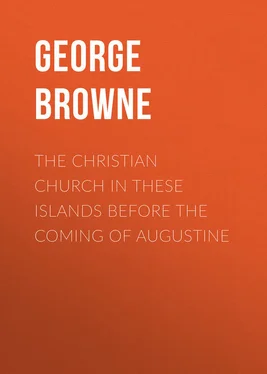George Browne - The Christian Church in These Islands before the Coming of Augustine
Здесь есть возможность читать онлайн «George Browne - The Christian Church in These Islands before the Coming of Augustine» — ознакомительный отрывок электронной книги совершенно бесплатно, а после прочтения отрывка купить полную версию. В некоторых случаях можно слушать аудио, скачать через торрент в формате fb2 и присутствует краткое содержание. Жанр: foreign_antique, foreign_prose, Историческая проза, на английском языке. Описание произведения, (предисловие) а так же отзывы посетителей доступны на портале библиотеки ЛибКат.
- Название:The Christian Church in These Islands before the Coming of Augustine
- Автор:
- Жанр:
- Год:неизвестен
- ISBN:нет данных
- Рейтинг книги:4 / 5. Голосов: 1
-
Избранное:Добавить в избранное
- Отзывы:
-
Ваша оценка:
- 80
- 1
- 2
- 3
- 4
- 5
The Christian Church in These Islands before the Coming of Augustine: краткое содержание, описание и аннотация
Предлагаем к чтению аннотацию, описание, краткое содержание или предисловие (зависит от того, что написал сам автор книги «The Christian Church in These Islands before the Coming of Augustine»). Если вы не нашли необходимую информацию о книге — напишите в комментариях, мы постараемся отыскать её.
The Christian Church in These Islands before the Coming of Augustine — читать онлайн ознакомительный отрывок
Ниже представлен текст книги, разбитый по страницам. Система сохранения места последней прочитанной страницы, позволяет с удобством читать онлайн бесплатно книгу «The Christian Church in These Islands before the Coming of Augustine», без необходимости каждый раз заново искать на чём Вы остановились. Поставьте закладку, и сможете в любой момент перейти на страницу, на которой закончили чтение.
Интервал:
Закладка:
About a. d. 545, a great plague raged at Soissons, and the people begged for the return of their bishop. He went back to his old charge, and there is no suggestion that he ever left it again. This legend of a Bishop of Soissons coming to our island, may well have given rise to the tradition that Bishop Luidhard, who certainly was living in the time of Bandaridus, had been Bishop of Soissons. In any case, the incidental hint the story gives us of the skill of our neighbours on the continent in the cultivation of vegetables, even at that early time, makes the story worth reproduction. The Bishop of Soissons, at the time of which we are speaking, was Droctigisilus (variously spelled, as might perhaps be expected). Of him Gregory of Tours tells that he lost his senses through over-drinking. Gregory adds a moral reflection – if we can so describe it – which does not give us a very high idea of the practical Christianity of the times. It is this: – “Though he was a voracious eater, and drank immoderately, exceeding the bounds which priestly caution should impose, no one ever accused him of adultery 4 4 Ecclesiastical History of the Franks, ix. 37.
.” If we must choose a bishop of Soissons to be represented by Luidhard, we may fairly prefer the vegetable-gardener to the immoderate drinker.
We read, again, in fairly early times, that our first Christian bishop in England had been bishop of Senlis. The authors and compilers of Gallia Christiana insert the name of Lethardus, or Letaldus, among the bishops of Senlis, quoting Sprot and Thorn. He was said to have come over with Bertha as early as 566, and they insert him accordingly after a bishop who subscribed at the third Council of Paris in 557. Jacques du Perron, bishop of Angoulême, almoner to Queen Henrietta Maria, took this view of his predecessor, the almoner of Queen Bertha, that he had been Bishop of Senlis. The parallel which he drew between the two cases of the first Christian queen and her almoner, and the first Romanist queen after the final rupture and her almoner, was much in point. “Gaul it was that sent to the English their first Christian queen. The clergy of Gaul it was that sent them their first bishop, her almoner.” But the sacramentary of Senlis, the calendar of commemorations, and the list of bishops, all are silent as to this Bishop Lethardus. Let me note for future use that these places, Soissons and Senlis, were in Belgic Gaul, that part of the continent which was directly opposite to the south-eastern parts of Britain.
I have said more about the diocese to which Luidhard may have belonged than I think the question deserves. This is done out of respect to my predecessors in the enquiry. The idea that a bishop must have had a see is natural enough to us, but is not according to knowledge. A hundred and fifty years later than this, there were so many wandering bishops in Gaul, that a synod held in this very diocese of Soissons declared that wandering bishops must not ordain priests; but that if any priests thus ordained were good priests, they should be reordained. And a great Council of all the bishops of Gaul, held at Verneuil in 755, declared that wandering bishops, who had not dioceses, should be incapable of performing any function without permission of the diocesan bishop. There is no suggestion that these were foreign bishops; and it was before the time when the invasions of Ireland by the Danes drove into England and on to the continent a perfect plague of Irish ecclesiastics calling themselves bishops. I think it is on the whole fair to say that the more you study the early history of episcopacy in these parts of Europe, the less need you feel to find a see for Bishop Luidhard.
There is one very interesting fact, which deserves to be noted in connection with this mysterious Gallican bishop. The Italian Mission paid very special honour to his memory and his remains. There is in the first volume of Dugdale’s Monasticon 5 5 Page 120.
a copy of an ancient drawing of St. Augustine’s, Canterbury. This is not, of course, the Cathedral Church, which was an old church of the British times restored by Augustine and dedicated to the Saviour; “Christ Church” it still remains. St. Augustine’s was the church and monastery begun in Augustine’s lifetime, and dedicated soon after his death to St. Peter and St. Paul, as Bede (i. 33) and various documents tell us precisely. This fact, that the church was dedicated to St. Peter and St. Paul, was represented last June, when “the renewal of the dedication of England to St. Mary and St. Peter” took place 6 6 Daily Chronicle , June 30, 1893.
, by the statement that “the first great abbey church of Canterbury was dedicated to St. Peter.” In the preparatory pastoral, signed by Cardinal Vaughan and fourteen other Roman Catholic Bishops, dated May 20, 1893, the statement took this form 7 7 Standard , May 30, 1893.
: – “The second monastery of Canterbury was dedicated to St. Peter himself.” Not only is that not so, but I cannot find evidence that Augustine dedicated any church anywhere “to St. Peter himself.” Of the two Apostles, St. Peter and St. Paul, who were united in the earliest of all Saints’ days, and still are so united in the Calendar of the Roman Church, though we have given to them two separate days, of the two, if we must choose one of them, St. Paul, not St. Peter, was made by Augustine the Apostle of England. To St. Paul was dedicated the first church in England dedicated to either of the two “himself,” that is, alone; and that, too, this church, the first and cathedral church of the greater of the two places assigned by Gregory as the two Metropolitical sees of England, London and York.
The “dedication of England to St. Mary” has a similar difficulty to face. There is no evidence that Augustine assigned any dedication to the Blessed Virgin. The first church mentioned with that dedication was built by Laurentius and dedicated by Mellitus. But if twenty churches had been dedicated by Augustine to the Virgin and to St. Peter, England would have been the richer by twenty churches, and that would have been all.
The ancient drawing to which I am referring was made after 1325, when St. Ethelbert was added to the Apostles Peter and Paul and St. Augustine in the dedication of the high altar. It was copied for Sir William Dugdale’s purposes in 1652, at which time it had passed into the safe hands of one of the Cambridge Colleges, Trinity Hall. The altar is shewn as deeply recessed into a structural reredos. A large number of shrines are shewn, ranged in semi-circles behind the reredos. On either side of the altar there is a door, as in our reredos at St. Paul’s. They are marked “north door” and “south door,” “to the bodies of the saints.” On the shrines, shewn in the apse to which these doors lead, are written the names of those whose relics they contained, and the roll of names is illustrious. In the centre, at the extreme east, is Augustine, with Laurentius and Mellitus north and south of him: then, on the north, Justus, Deusdedit, Mildred, Nothelm, and Lambert; on the south, Honorius, Theodore, Abbat Hadrian, Berhtwald, and Tatwin. Besides these shrines in the apse, behind the reredos, there is shewn immediately above the altar itself a prominent shrine, marked Scs. Ethelbertus, the relics of the first Christian king. Then, behind that, a number of books – manuscripts, of course – with a Latin description stating that they are “books sent by Gregory to Augustine” – one or two of which are still in existence. Above these, on either side of a great vesica enclosing a representation of our Lord, are two shrines, one marked “Relics,” the other, which stands on the side of greater honour, is marked Scs. Letald(us). Thus the Canterbury monks at St. Augustine’s, the great treasure-house of early Canterbury saints, put in the places of highest honour the relics of Bertha’s husband and of Bertha’s Gallican bishop. It is a pleasant thought in these days of ecclesiastical jealousies – and when were there days, before Christ or since, without ecclesiastical jealousies? – it is a very pleasant thought that the successors of Augustine paid such honour to Augustine’s Gallican precursor, whose work they might almost have been expected, considering the temper of the times, to be inclined to ignore. The shrine with Luidhard’s relics no doubt represents the golden chest in which – as we know – they used to carry his relics round Canterbury on Rogation Days.
Читать дальшеИнтервал:
Закладка:
Похожие книги на «The Christian Church in These Islands before the Coming of Augustine»
Представляем Вашему вниманию похожие книги на «The Christian Church in These Islands before the Coming of Augustine» списком для выбора. Мы отобрали схожую по названию и смыслу литературу в надежде предоставить читателям больше вариантов отыскать новые, интересные, ещё непрочитанные произведения.
Обсуждение, отзывы о книге «The Christian Church in These Islands before the Coming of Augustine» и просто собственные мнения читателей. Оставьте ваши комментарии, напишите, что Вы думаете о произведении, его смысле или главных героях. Укажите что конкретно понравилось, а что нет, и почему Вы так считаете.












